Company Accounting: Cost Model, Fair Value, and Financial Analysis
VerifiedAdded on 2023/06/12
|8
|1428
|149
Homework Assignment
AI Summary
This assignment delves into various aspects of company accounting, focusing on the cost model and fair value concepts. It includes a detailed examination of journal entries, depreciation calculations, and the treatment of revaluation gains and losses. The assignment identifies and rectifies errors in provided journal entries related to asset revaluation, demonstrating the correct accounting treatment for accumulated depreciation and revaluation losses. Furthermore, it addresses the accounting for impairment losses, including the determination of recoverable amounts and the recognition of impairment losses in the financial statements. The document also covers the subsequent depreciation of revalued assets and the transfer of revaluation gains to the revaluation reserve and statement of comprehensive income. Desklib provides students with access to this solved assignment and other valuable study resources.
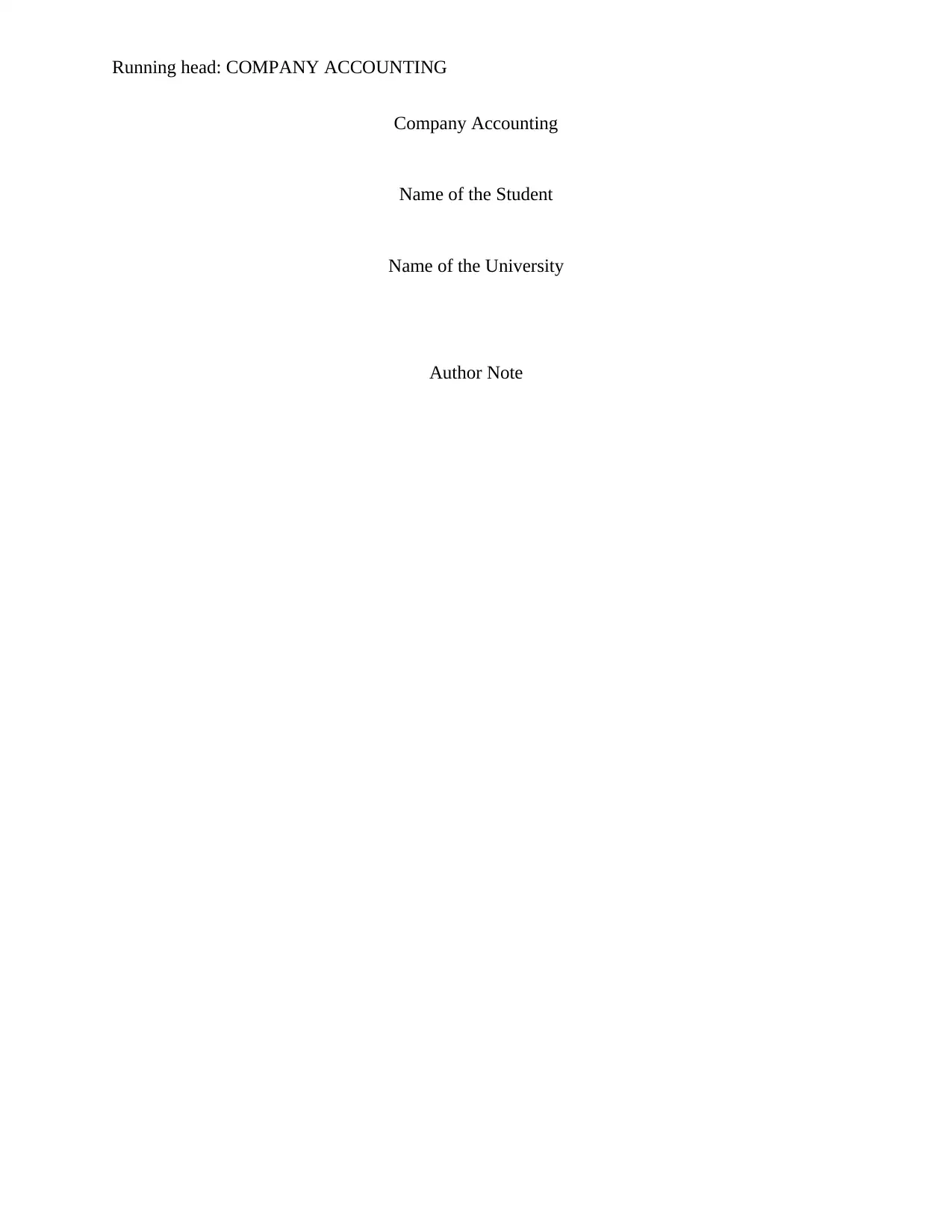
Running head: COMPANY ACCOUNTING
Company Accounting
Name of the Student
Name of the University
Author Note
Company Accounting
Name of the Student
Name of the University
Author Note
Paraphrase This Document
Need a fresh take? Get an instant paraphrase of this document with our AI Paraphraser
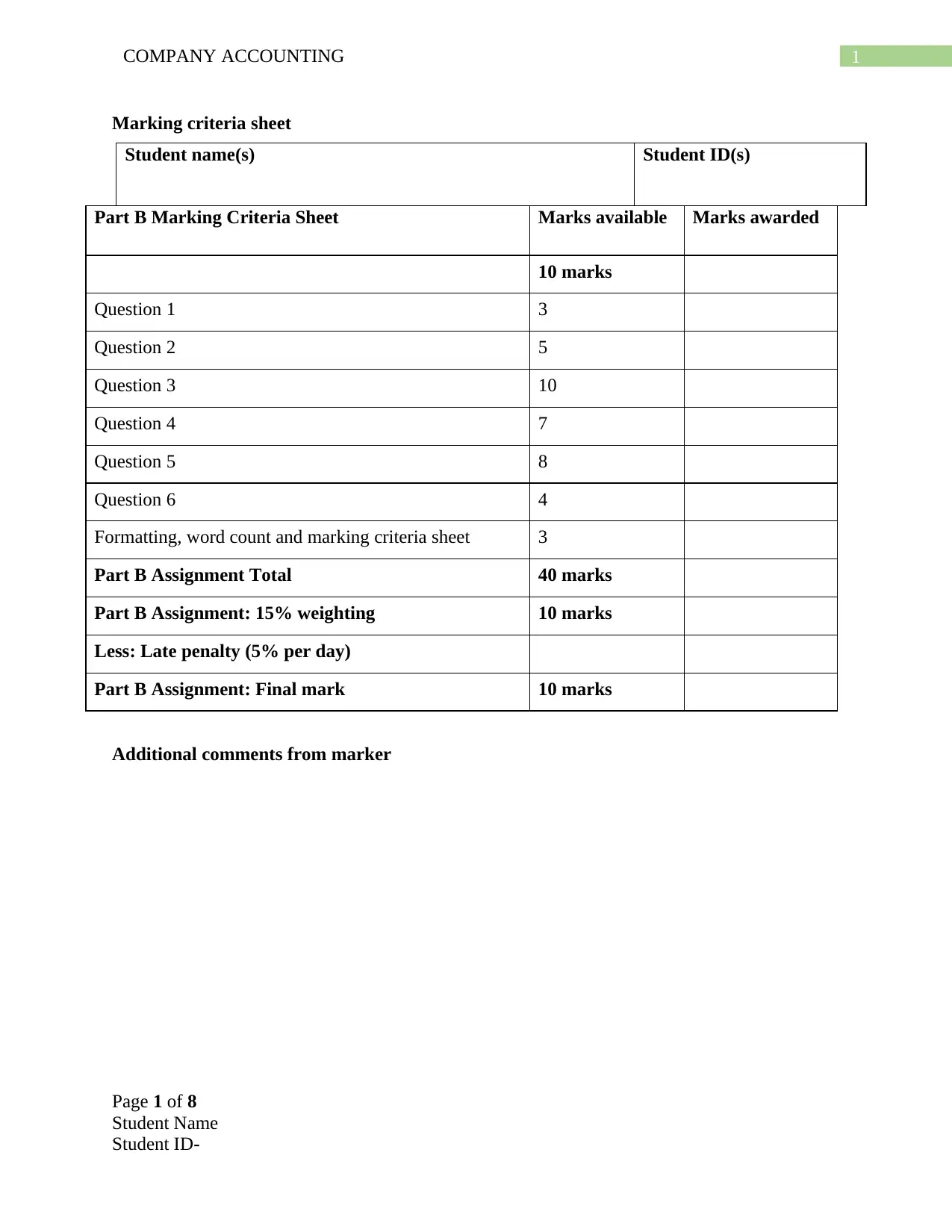
1COMPANY ACCOUNTING
Marking criteria sheet
Student name(s) Student ID(s)
Part B Marking Criteria Sheet Marks available Marks awarded
10 marks
Question 1 3
Question 2 5
Question 3 10
Question 4 7
Question 5 8
Question 6 4
Formatting, word count and marking criteria sheet 3
Part B Assignment Total 40 marks
Part B Assignment: 15% weighting 10 marks
Less: Late penalty (5% per day)
Part B Assignment: Final mark 10 marks
Additional comments from marker
Page 1 of 8
Student Name
Student ID-
Marking criteria sheet
Student name(s) Student ID(s)
Part B Marking Criteria Sheet Marks available Marks awarded
10 marks
Question 1 3
Question 2 5
Question 3 10
Question 4 7
Question 5 8
Question 6 4
Formatting, word count and marking criteria sheet 3
Part B Assignment Total 40 marks
Part B Assignment: 15% weighting 10 marks
Less: Late penalty (5% per day)
Part B Assignment: Final mark 10 marks
Additional comments from marker
Page 1 of 8
Student Name
Student ID-
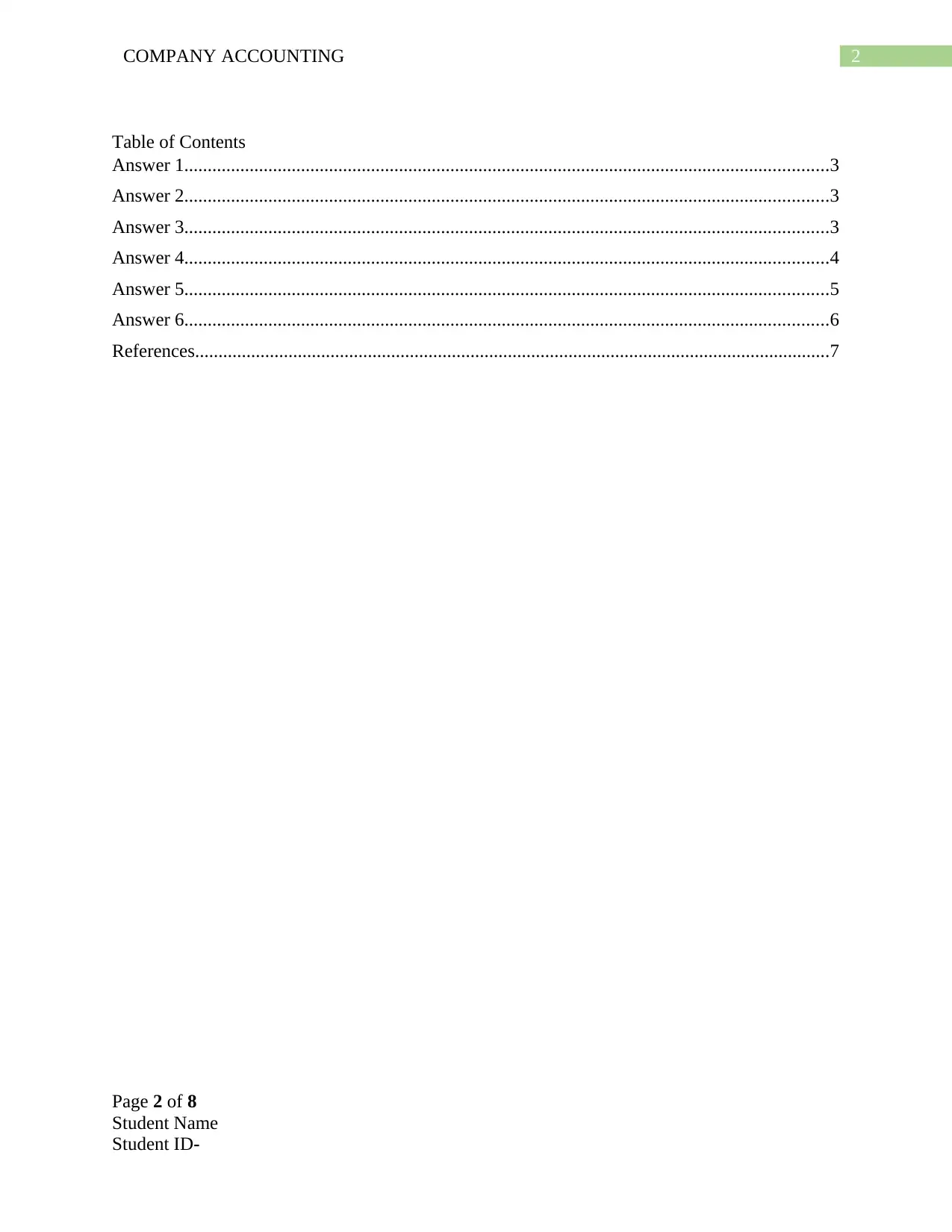
2COMPANY ACCOUNTING
Table of Contents
Answer 1..........................................................................................................................................3
Answer 2..........................................................................................................................................3
Answer 3..........................................................................................................................................3
Answer 4..........................................................................................................................................4
Answer 5..........................................................................................................................................5
Answer 6..........................................................................................................................................6
References........................................................................................................................................7
Page 2 of 8
Student Name
Student ID-
Table of Contents
Answer 1..........................................................................................................................................3
Answer 2..........................................................................................................................................3
Answer 3..........................................................................................................................................3
Answer 4..........................................................................................................................................4
Answer 5..........................................................................................................................................5
Answer 6..........................................................................................................................................6
References........................................................................................................................................7
Page 2 of 8
Student Name
Student ID-
⊘ This is a preview!⊘
Do you want full access?
Subscribe today to unlock all pages.

Trusted by 1+ million students worldwide
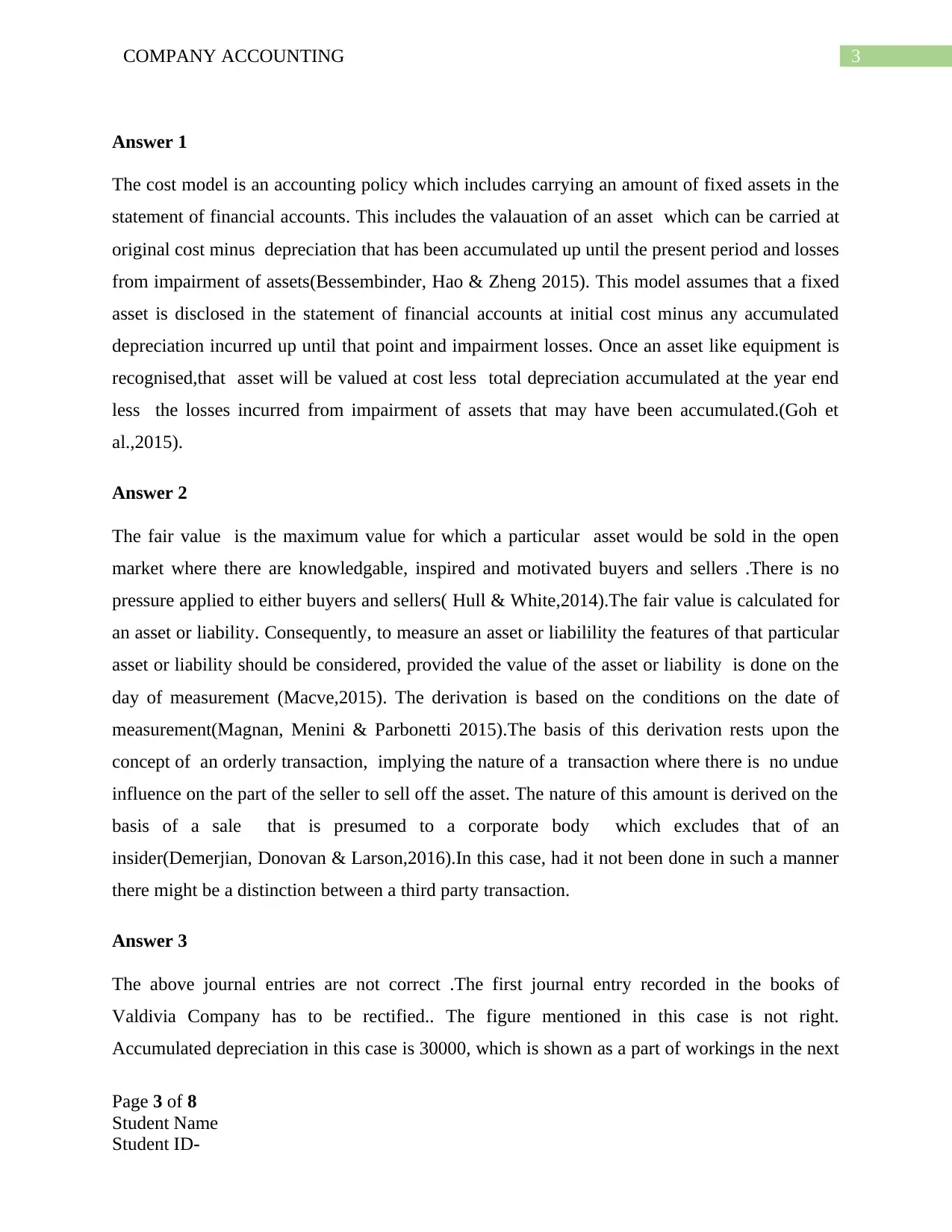
3COMPANY ACCOUNTING
Answer 1
The cost model is an accounting policy which includes carrying an amount of fixed assets in the
statement of financial accounts. This includes the valauation of an asset which can be carried at
original cost minus depreciation that has been accumulated up until the present period and losses
from impairment of assets(Bessembinder, Hao & Zheng 2015). This model assumes that a fixed
asset is disclosed in the statement of financial accounts at initial cost minus any accumulated
depreciation incurred up until that point and impairment losses. Once an asset like equipment is
recognised,that asset will be valued at cost less total depreciation accumulated at the year end
less the losses incurred from impairment of assets that may have been accumulated.(Goh et
al.,2015).
Answer 2
The fair value is the maximum value for which a particular asset would be sold in the open
market where there are knowledgable, inspired and motivated buyers and sellers .There is no
pressure applied to either buyers and sellers( Hull & White,2014).The fair value is calculated for
an asset or liability. Consequently, to measure an asset or liabilility the features of that particular
asset or liability should be considered, provided the value of the asset or liability is done on the
day of measurement (Macve,2015). The derivation is based on the conditions on the date of
measurement(Magnan, Menini & Parbonetti 2015).The basis of this derivation rests upon the
concept of an orderly transaction, implying the nature of a transaction where there is no undue
influence on the part of the seller to sell off the asset. The nature of this amount is derived on the
basis of a sale that is presumed to a corporate body which excludes that of an
insider(Demerjian, Donovan & Larson,2016).In this case, had it not been done in such a manner
there might be a distinction between a third party transaction.
Answer 3
The above journal entries are not correct .The first journal entry recorded in the books of
Valdivia Company has to be rectified.. The figure mentioned in this case is not right.
Accumulated depreciation in this case is 30000, which is shown as a part of workings in the next
Page 3 of 8
Student Name
Student ID-
Answer 1
The cost model is an accounting policy which includes carrying an amount of fixed assets in the
statement of financial accounts. This includes the valauation of an asset which can be carried at
original cost minus depreciation that has been accumulated up until the present period and losses
from impairment of assets(Bessembinder, Hao & Zheng 2015). This model assumes that a fixed
asset is disclosed in the statement of financial accounts at initial cost minus any accumulated
depreciation incurred up until that point and impairment losses. Once an asset like equipment is
recognised,that asset will be valued at cost less total depreciation accumulated at the year end
less the losses incurred from impairment of assets that may have been accumulated.(Goh et
al.,2015).
Answer 2
The fair value is the maximum value for which a particular asset would be sold in the open
market where there are knowledgable, inspired and motivated buyers and sellers .There is no
pressure applied to either buyers and sellers( Hull & White,2014).The fair value is calculated for
an asset or liability. Consequently, to measure an asset or liabilility the features of that particular
asset or liability should be considered, provided the value of the asset or liability is done on the
day of measurement (Macve,2015). The derivation is based on the conditions on the date of
measurement(Magnan, Menini & Parbonetti 2015).The basis of this derivation rests upon the
concept of an orderly transaction, implying the nature of a transaction where there is no undue
influence on the part of the seller to sell off the asset. The nature of this amount is derived on the
basis of a sale that is presumed to a corporate body which excludes that of an
insider(Demerjian, Donovan & Larson,2016).In this case, had it not been done in such a manner
there might be a distinction between a third party transaction.
Answer 3
The above journal entries are not correct .The first journal entry recorded in the books of
Valdivia Company has to be rectified.. The figure mentioned in this case is not right.
Accumulated depreciation in this case is 30000, which is shown as a part of workings in the next
Page 3 of 8
Student Name
Student ID-
Paraphrase This Document
Need a fresh take? Get an instant paraphrase of this document with our AI Paraphraser
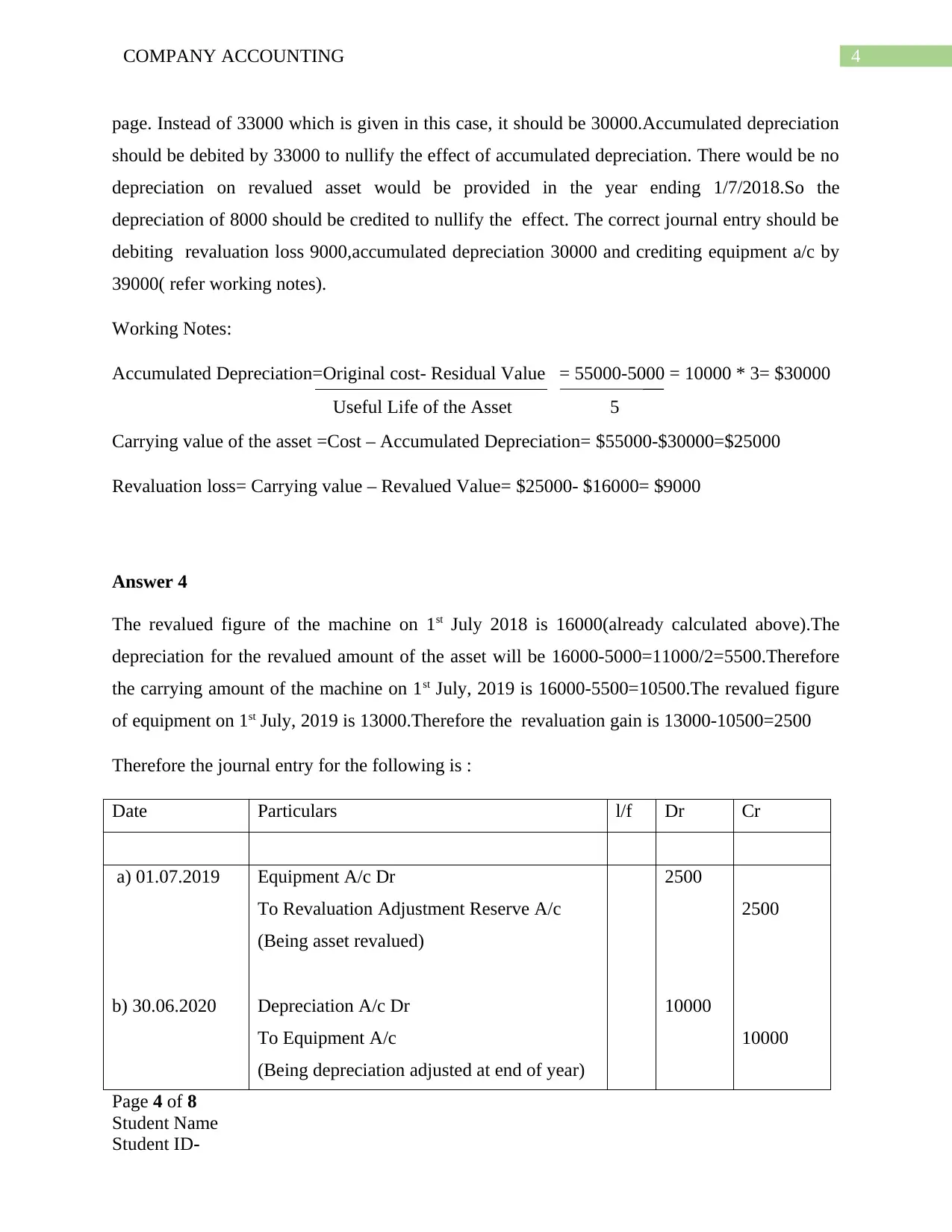
4COMPANY ACCOUNTING
page. Instead of 33000 which is given in this case, it should be 30000.Accumulated depreciation
should be debited by 33000 to nullify the effect of accumulated depreciation. There would be no
depreciation on revalued asset would be provided in the year ending 1/7/2018.So the
depreciation of 8000 should be credited to nullify the effect. The correct journal entry should be
debiting revaluation loss 9000,accumulated depreciation 30000 and crediting equipment a/c by
39000( refer working notes).
Working Notes:
Accumulated Depreciation=Original cost- Residual Value = 55000-5000 = 10000 * 3= $30000
Useful Life of the Asset 5
Carrying value of the asset =Cost – Accumulated Depreciation= $55000-$30000=$25000
Revaluation loss= Carrying value – Revalued Value= $25000- $16000= $9000
Answer 4
The revalued figure of the machine on 1st July 2018 is 16000(already calculated above).The
depreciation for the revalued amount of the asset will be 16000-5000=11000/2=5500.Therefore
the carrying amount of the machine on 1st July, 2019 is 16000-5500=10500.The revalued figure
of equipment on 1st July, 2019 is 13000.Therefore the revaluation gain is 13000-10500=2500
Therefore the journal entry for the following is :
Date Particulars l/f Dr Cr
a) 01.07.2019
b) 30.06.2020
Equipment A/c Dr
To Revaluation Adjustment Reserve A/c
(Being asset revalued)
Depreciation A/c Dr
To Equipment A/c
(Being depreciation adjusted at end of year)
2500
10000
2500
10000
Page 4 of 8
Student Name
Student ID-
page. Instead of 33000 which is given in this case, it should be 30000.Accumulated depreciation
should be debited by 33000 to nullify the effect of accumulated depreciation. There would be no
depreciation on revalued asset would be provided in the year ending 1/7/2018.So the
depreciation of 8000 should be credited to nullify the effect. The correct journal entry should be
debiting revaluation loss 9000,accumulated depreciation 30000 and crediting equipment a/c by
39000( refer working notes).
Working Notes:
Accumulated Depreciation=Original cost- Residual Value = 55000-5000 = 10000 * 3= $30000
Useful Life of the Asset 5
Carrying value of the asset =Cost – Accumulated Depreciation= $55000-$30000=$25000
Revaluation loss= Carrying value – Revalued Value= $25000- $16000= $9000
Answer 4
The revalued figure of the machine on 1st July 2018 is 16000(already calculated above).The
depreciation for the revalued amount of the asset will be 16000-5000=11000/2=5500.Therefore
the carrying amount of the machine on 1st July, 2019 is 16000-5500=10500.The revalued figure
of equipment on 1st July, 2019 is 13000.Therefore the revaluation gain is 13000-10500=2500
Therefore the journal entry for the following is :
Date Particulars l/f Dr Cr
a) 01.07.2019
b) 30.06.2020
Equipment A/c Dr
To Revaluation Adjustment Reserve A/c
(Being asset revalued)
Depreciation A/c Dr
To Equipment A/c
(Being depreciation adjusted at end of year)
2500
10000
2500
10000
Page 4 of 8
Student Name
Student ID-
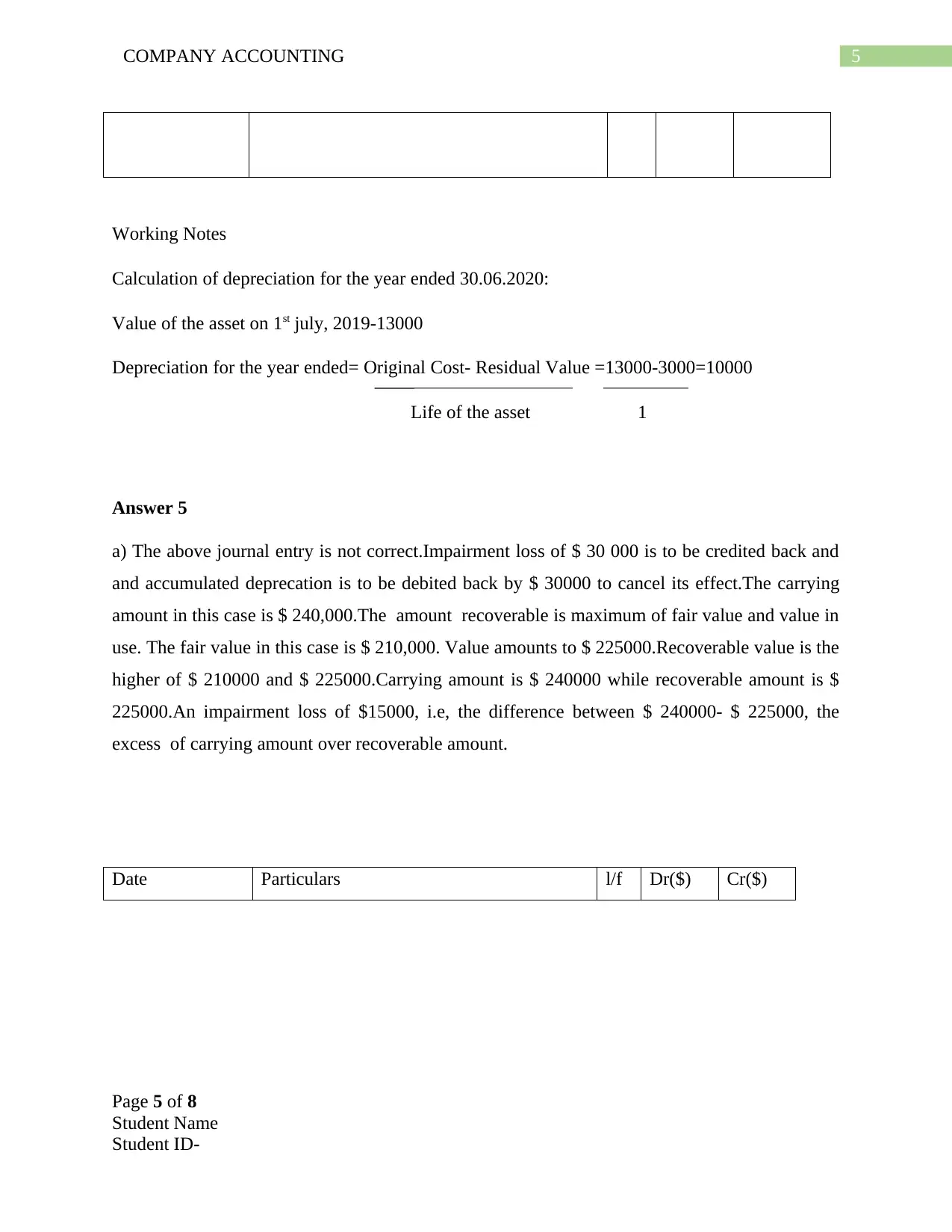
5COMPANY ACCOUNTING
Working Notes
Calculation of depreciation for the year ended 30.06.2020:
Value of the asset on 1st july, 2019-13000
Depreciation for the year ended= Original Cost- Residual Value =13000-3000=10000
Life of the asset 1
Answer 5
a) The above journal entry is not correct.Impairment loss of $ 30 000 is to be credited back and
and accumulated deprecation is to be debited back by $ 30000 to cancel its effect.The carrying
amount in this case is $ 240,000.The amount recoverable is maximum of fair value and value in
use. The fair value in this case is $ 210,000. Value amounts to $ 225000.Recoverable value is the
higher of $ 210000 and $ 225000.Carrying amount is $ 240000 while recoverable amount is $
225000.An impairment loss of $15000, i.e, the difference between $ 240000- $ 225000, the
excess of carrying amount over recoverable amount.
Date Particulars l/f Dr($) Cr($)
Page 5 of 8
Student Name
Student ID-
Working Notes
Calculation of depreciation for the year ended 30.06.2020:
Value of the asset on 1st july, 2019-13000
Depreciation for the year ended= Original Cost- Residual Value =13000-3000=10000
Life of the asset 1
Answer 5
a) The above journal entry is not correct.Impairment loss of $ 30 000 is to be credited back and
and accumulated deprecation is to be debited back by $ 30000 to cancel its effect.The carrying
amount in this case is $ 240,000.The amount recoverable is maximum of fair value and value in
use. The fair value in this case is $ 210,000. Value amounts to $ 225000.Recoverable value is the
higher of $ 210000 and $ 225000.Carrying amount is $ 240000 while recoverable amount is $
225000.An impairment loss of $15000, i.e, the difference between $ 240000- $ 225000, the
excess of carrying amount over recoverable amount.
Date Particulars l/f Dr($) Cr($)
Page 5 of 8
Student Name
Student ID-
⊘ This is a preview!⊘
Do you want full access?
Subscribe today to unlock all pages.

Trusted by 1+ million students worldwide
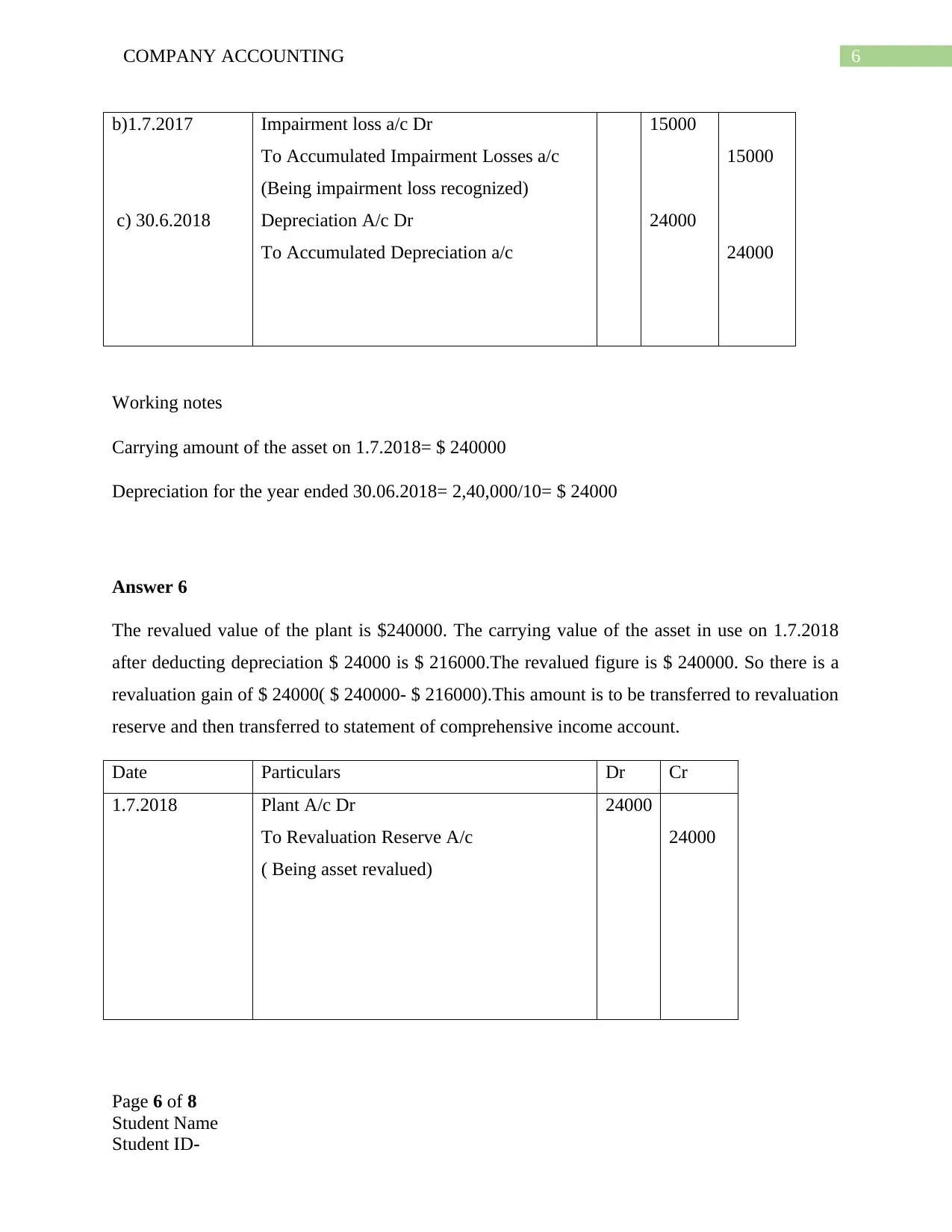
6COMPANY ACCOUNTING
b)1.7.2017
c) 30.6.2018
Impairment loss a/c Dr
To Accumulated Impairment Losses a/c
(Being impairment loss recognized)
Depreciation A/c Dr
To Accumulated Depreciation a/c
15000
24000
15000
24000
Working notes
Carrying amount of the asset on 1.7.2018= $ 240000
Depreciation for the year ended 30.06.2018= 2,40,000/10= $ 24000
Answer 6
The revalued value of the plant is $240000. The carrying value of the asset in use on 1.7.2018
after deducting depreciation $ 24000 is $ 216000.The revalued figure is $ 240000. So there is a
revaluation gain of $ 24000( $ 240000- $ 216000).This amount is to be transferred to revaluation
reserve and then transferred to statement of comprehensive income account.
Date Particulars Dr Cr
1.7.2018 Plant A/c Dr
To Revaluation Reserve A/c
( Being asset revalued)
24000
24000
Page 6 of 8
Student Name
Student ID-
b)1.7.2017
c) 30.6.2018
Impairment loss a/c Dr
To Accumulated Impairment Losses a/c
(Being impairment loss recognized)
Depreciation A/c Dr
To Accumulated Depreciation a/c
15000
24000
15000
24000
Working notes
Carrying amount of the asset on 1.7.2018= $ 240000
Depreciation for the year ended 30.06.2018= 2,40,000/10= $ 24000
Answer 6
The revalued value of the plant is $240000. The carrying value of the asset in use on 1.7.2018
after deducting depreciation $ 24000 is $ 216000.The revalued figure is $ 240000. So there is a
revaluation gain of $ 24000( $ 240000- $ 216000).This amount is to be transferred to revaluation
reserve and then transferred to statement of comprehensive income account.
Date Particulars Dr Cr
1.7.2018 Plant A/c Dr
To Revaluation Reserve A/c
( Being asset revalued)
24000
24000
Page 6 of 8
Student Name
Student ID-
Paraphrase This Document
Need a fresh take? Get an instant paraphrase of this document with our AI Paraphraser
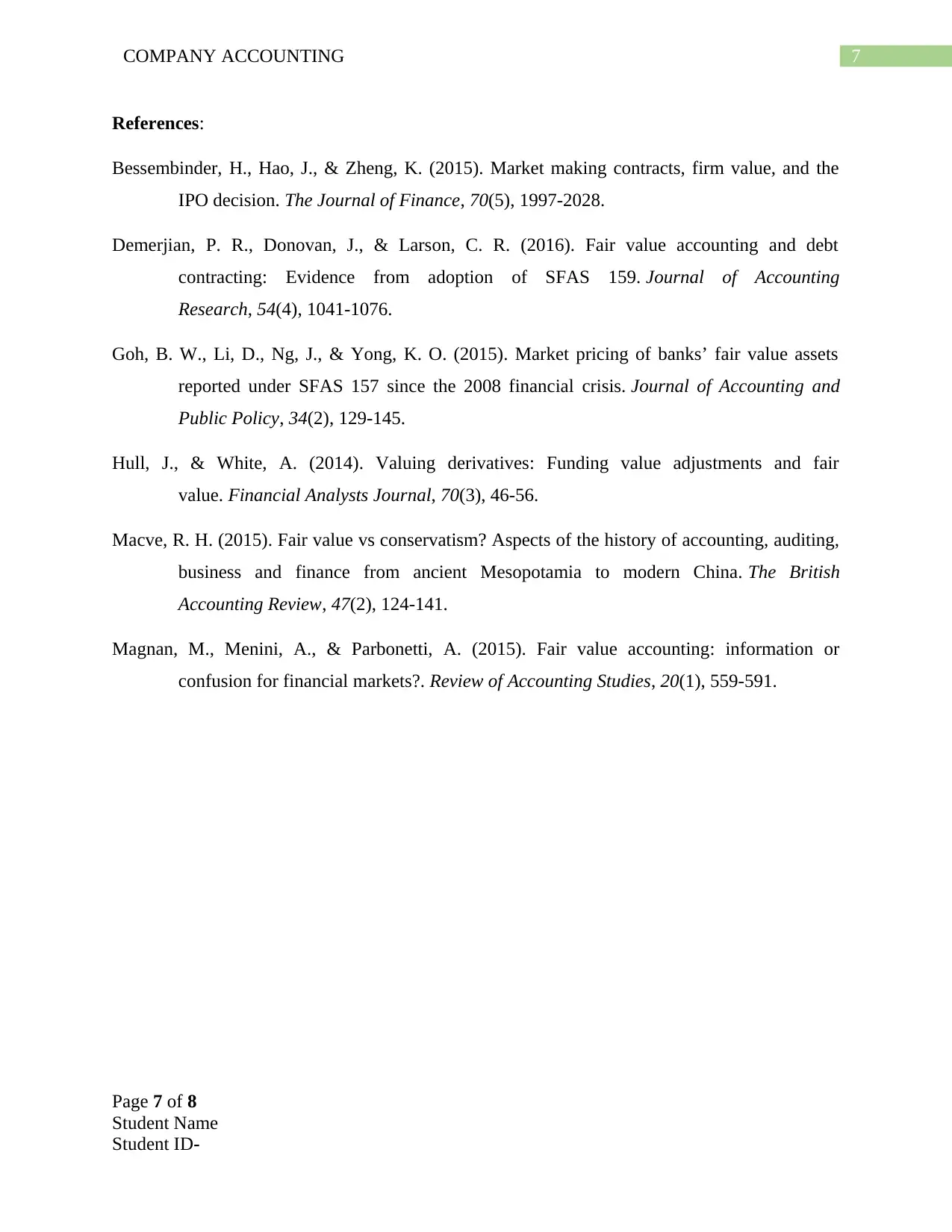
7COMPANY ACCOUNTING
References:
Bessembinder, H., Hao, J., & Zheng, K. (2015). Market making contracts, firm value, and the
IPO decision. The Journal of Finance, 70(5), 1997-2028.
Demerjian, P. R., Donovan, J., & Larson, C. R. (2016). Fair value accounting and debt
contracting: Evidence from adoption of SFAS 159. Journal of Accounting
Research, 54(4), 1041-1076.
Goh, B. W., Li, D., Ng, J., & Yong, K. O. (2015). Market pricing of banks’ fair value assets
reported under SFAS 157 since the 2008 financial crisis. Journal of Accounting and
Public Policy, 34(2), 129-145.
Hull, J., & White, A. (2014). Valuing derivatives: Funding value adjustments and fair
value. Financial Analysts Journal, 70(3), 46-56.
Macve, R. H. (2015). Fair value vs conservatism? Aspects of the history of accounting, auditing,
business and finance from ancient Mesopotamia to modern China. The British
Accounting Review, 47(2), 124-141.
Magnan, M., Menini, A., & Parbonetti, A. (2015). Fair value accounting: information or
confusion for financial markets?. Review of Accounting Studies, 20(1), 559-591.
Page 7 of 8
Student Name
Student ID-
References:
Bessembinder, H., Hao, J., & Zheng, K. (2015). Market making contracts, firm value, and the
IPO decision. The Journal of Finance, 70(5), 1997-2028.
Demerjian, P. R., Donovan, J., & Larson, C. R. (2016). Fair value accounting and debt
contracting: Evidence from adoption of SFAS 159. Journal of Accounting
Research, 54(4), 1041-1076.
Goh, B. W., Li, D., Ng, J., & Yong, K. O. (2015). Market pricing of banks’ fair value assets
reported under SFAS 157 since the 2008 financial crisis. Journal of Accounting and
Public Policy, 34(2), 129-145.
Hull, J., & White, A. (2014). Valuing derivatives: Funding value adjustments and fair
value. Financial Analysts Journal, 70(3), 46-56.
Macve, R. H. (2015). Fair value vs conservatism? Aspects of the history of accounting, auditing,
business and finance from ancient Mesopotamia to modern China. The British
Accounting Review, 47(2), 124-141.
Magnan, M., Menini, A., & Parbonetti, A. (2015). Fair value accounting: information or
confusion for financial markets?. Review of Accounting Studies, 20(1), 559-591.
Page 7 of 8
Student Name
Student ID-
1 out of 8
Related Documents
Your All-in-One AI-Powered Toolkit for Academic Success.
+13062052269
info@desklib.com
Available 24*7 on WhatsApp / Email
![[object Object]](/_next/static/media/star-bottom.7253800d.svg)
Unlock your academic potential
Copyright © 2020–2025 A2Z Services. All Rights Reserved. Developed and managed by ZUCOL.





